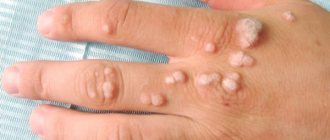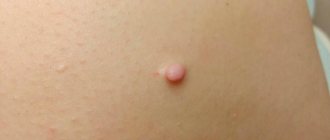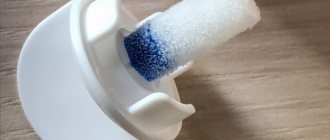During menstruation, the pain threshold is lowered, and recovery takes longer. Pregnant women should postpone the procedure for the same reasons. Any changes/disturbances in hormonal levels can make laser wart removal ineffective.
Contraindications also include some diseases:
- dermatological;
- infectious;
- viral;
- endocrine;
- cardiovascular;
- hormonal;
- oncological;
- autoimmune, etc.
In case of exacerbation of chronic disorders or deterioration of health, it is advisable to reschedule the procedure.
Features of the laser wart removal procedure
Therapy is not carried out if it is necessary to preserve the tumor tissue for further study. Warts are not simply removed: the device completely destroys biological material. So it is impossible to combine laser with histological examination. Samples can only be taken before the procedure is scheduled, otherwise the patient is offered other methods
Preliminary consultation is required. A dermatologist performs a visual examination and collects anamnesis to identify contraindications. The absence of visible diseases is confirmed by the results of a general blood test.
If there are no health problems, the patient is sent for examination to an oncologist. It is important to make sure in advance that the nevus being removed is a benign tumor. This will eliminate some possible complications, including the risk of developing cancer cells.
Where to remove warts?
You can remove warts on your hands, fingers, face or body at any of our centers. You can choose any center convenient for you; our centers are located near the metro.
The initial consultation with a cosmetologist at the REDNOR cosmetology centers regarding the removal of warts during the procedure on the day of the consultation is FREE.
You can consult a doctor and have a wart removed by first making an appointment by calling
+7
Mon-Fri: 9:00-20:00, Sat: 9:00-18:00
Sign up for a consultation
How does the laser wart removal procedure work?
Therapy is started after examination. The procedure is performed on an outpatient basis - immediately or on a previously agreed day.
Laser removal consists of 4-5 stages:
- Disinfection. The skin is prepared by cleaning it from street dust, as well as remnants of cosmetics or care products. Next comes mandatory disinfection - the treated area is wiped with an antiseptic.
- Anesthesia. If desired, local anesthesia is acceptable; doctors use various gels, sprays or ointments. And for large warts, they offer pain relief with an injection administered subcutaneously. General anesthesia is rarely used and only in certain situations.
- Equipment setup. The specialist selects the power and wavelength, adjusting the laser to the patient’s problem.
- Delete. Sequential heating and destruction of neoplasm cells are carried out. The laser does not affect surrounding tissues.
- Repeated disinfection. The doctor disinfects the treated area and gives recommendations for care.
To avoid contamination, the wound is covered with a plaster or bandage. Clinics often sell products that accelerate regeneration; with them, the skin will heal faster. Removing a small wart will not cost much, but anesthesia and some consumables may not be included in the basic cost.
Number of required procedures
To eliminate a small wart or mole, it is enough to do 1 procedure. Often a session takes no more than 10 minutes, and only when working with a large area does the process last for half an hour or even an hour. During this time, the specialist completely removes the unwanted formation.
In rare cases, dermatologists offer a course of 2-3 sessions, the required interval is at least 7 days. This option is used for patients with sensitive skin, especially if it is necessary to treat a large number of moles or papillomas.
More often, removal in several stages is carried out for highly overgrown formations. If all rules of procedure and care are followed, there is no need for prophylaxis.
Advantages and disadvantages of the laser method
Advantages of the laser wart removal technique:
- no age restrictions;
- use for any part of the body;
- there is no bleeding;
- high performance;
- impact directly on education;
- relatively fast healing process;
- painlessness;
- low probability of relapse;
- in most cases it does not leave scars.
The laser device seals the vessels without affecting the surrounding tissue, which minimizes the risk of infection. Modern lasers are equipped with a cooling system to make the procedure painless. And for sensitive skin, local or general anesthesia is provided.
Disadvantages of the method:
- high price;
- the speed and quality of recovery depend on the patient’s characteristics;
- errors during the procedure/rehabilitation lead to complications;
- there is no guarantee of no relapses.
When removing formations on the feet, a person cannot walk for some time. In addition, a removed mole can no longer be checked for benignity: an examination must be carried out before the procedure.
Consequences and possible complications
Common consequences include the formation of scars and scars at the site of nevi. Scars are possible when a large area is exposed to the laser, as well as when “deep” warts are removed.
Sometimes scars occur for other reasons:
- individual predisposition;
- infection or damage to the wound;
- incorrect device settings (medical oversight);
- lack of care or errors during the rehabilitation period.
Immediately after the procedure, the skin may:
- blush;
- to swell;
- get sick;
- itch and itch.
This is a normal reaction to the procedure, as well as a short-term increase in temperature. But if the discomfort does not disappear within 5 days or longer, it is advisable to consult a doctor. Consultation is also necessary in cases where the treated area suddenly begins to hurt or swell.
Possible complications:
- High laser power may cause blisters and burns. They can also form when the depth of the wart is incorrectly determined.
- If a mole is removed partially or incorrectly, it can grow back. In rare situations, a benign tumor develops into melanoma.
Trauma to the sore leads to the development of secondary complications:
- infection;
- non-healing wound;
- persistent swelling or redness;
- formation of pronounced scars;
- hyperpigmentation.
When eliminating formations on the lower extremities, the risk of negative consequences is higher. Reviews indicate that laser removal of plantar warts occurs without serious complications. But for this, you must stay at home throughout the recovery period.
When is it necessary to remove papilloma?
Benign skin tumors cannot always be removed; sometimes observation and regular examinations are sufficient. The most common indications for removal are the following:
- papillomas located on visible parts of the body and causing psychological discomfort;
- papillomas that are constantly injured by clothing, jewelry, and a comb;
- neoplasms that increase in size, tend to spread, change size, shape and color;
- papillomas located in the intimate area or soles;
- if the tumor begins to hurt, itch or bleed.
Is it painful to remove a wart with a laser?
Soreness is influenced by 5 factors:
- treated area;
- size and depth of the nevus;
- laser type;
- duration of the procedure;
- pain threshold.
For small moles, cauterization is sufficient, while formations with a deep-lying core are more difficult to remove. In the first case, anesthesia is optional; some people voluntarily refuse it. The reason may be simple economy or allergies. Therefore, some of the reviews about laser wart removal are written about the painful procedure.
The use of local anesthesia in combination with modern equipment minimizes discomfort. For particularly complex cases, general anesthesia is acceptable.
Is it permissible to perform laser removal of warts in children?
Laser equipment is used to eliminate warts and port-wine stains without any age restrictions. The technique allows you to avoid possible complications after surgery; it is indicated in the presence of contraindications to alternative procedures.
It is impossible to eliminate the defect with internal medications or folk remedies. In some cases, birthmarks resolve on their own by the first year of life, but there are circumstances in which removal is preferable:
- it is painful for the child to walk or move;
- the defect interferes with movement and injury can easily occur;
- there is a risk of disfigurement of appearance;
- increasing the size of the formation.
Children under 5 years of age are susceptible to developing heel warts. As in the situation with “spots,” they can disappear on their own in 1-2 years. No treatment is required; consult a doctor only if there are suspicious symptoms or severe discomfort.
Reviews about laser removal of a plantar wart for a child are mostly positive, and relapses occur extremely rarely.
Types of warts
There are 4 main types of warts:
Common warts
A common (simple or vulgar) wart is the most common type of this disease. Simple warts form mainly on the surface of the hands, but can appear on any other part of the body. These types of warts are quite common in children. The reason for the appearance (in addition to decreased immunity) is the active interaction of the skin with the external environment. Common warts are formations with a diameter of 1 to 10 mm. The danger of these warts is that if you scratch them, the wart can also get under the nails, from where it is much more difficult to remove.
Plantar warts (Plantar warts) are a type of common warts that form on the feet and nearby tissues. Extremely sweaty feet can be an additional cause of plantar warts. This type of wart is one of the most uncomfortable, since with constant physical impact on the wart, it becomes irritated and begins to grow and spread (mainly inside the affected tissue). Plus, plantar warts are painful when stepped on. That is why plantar warts are recommended to be removed as soon as they appear.
If a plantar wart is not removed in time, it can develop into a mosaic formation, which is characterized by many foci of viral infection and extreme difficulty in treatment.
Flat warts
Flat warts (juvenile warts) are the rarest. Flat warts have a round or polygonal shape, the surface is flat and smooth, and practically do not rise above the surface of the skin. The cause of flat warts is as a result of irritation, cuts, scratches on the face and hands. Typically, flat warts appear on the back of the hands, on the feet, on the skin of the face, neck, and chest. Often, flat warts appear on the skin of the genitals and in the rectal area. Damage to flat warts can lead to their rapid spread and development of their most dangerous form - the appearance of formations of dozens or even hundreds of flat warts, which are extremely difficult to remove.
Quite often, flat warts disappear with age, but we recommend that you consult a doctor and identify the cause of the appearance of flat warts.
Genital warts (genital warts)
Genital warts are formed mainly on the genitals, groin and buttock areas. Genital warts (genital warts) are skin growths of flesh-colored, pink or reddish color, fused into one whole on one base in the form of a “leg”. If they are not removed, they can grow to a large size and cause significant health damage.
Senile warts
Senile warts are the least dangerous type of wart. The appearance of senile warts is not associated with a virus; they arise due to aging of the skin. Senile warts appear as gray, brown or black growths on the face, neck or throughout the body.
Causes of warts
What causes warts to appear is one of the most asked questions. There are many reasons why warts appear:
1. One of the reasons is infection with the human papillomavirus. It is believed that most people already have the virus. But due to strong immunity, no visible manifestations of the virus are observed. When the immune system is weakened (due to illness, stress, etc.), they may appear on the face or body.
2. Contact household method. By visiting any public place you can catch this virus. Small abrasions or cuts can also be a source of development and penetration of the virus. Failure to maintain personal hygiene can also cause infection.
3. Infection from mother to child during birth.
4. Sexual transmission of the virus. This especially applies to genital warts.
Wound healing time after laser wart removal
Immediately after the procedure, the doctor treats the problem area with an antiseptic. A small wound and redness remain at the site of formation: it is covered with a plaster or elastic bandage. For the first 3 days, the damaged area should not be touched or wet.
After laser removal of warts, the wound heals from 7 to 14 days. On the 3-5th day it becomes covered with a crust (scab), the condition of which must be monitored. Do not allow damage, and do not try to soak or remove ahead of time - the sore will go away on its own.
On average, it takes from 1 to 4 months for complete skin restoration. This period is individual and depends on the individual patient. The wound can take quite a long time to heal if the immune system is weakened for any reason.
Postoperative period
After removing a wart, a crust forms in its place, which is prohibited from being picked off yourself. Removing the scab before it dries can result in a scar. After some time, it will dry out on its own and disappear, provided that the doctor’s instructions are followed.
After the removal procedure, it is recommended to follow simple rules to eliminate the risk of complications:
- Avoid visiting saunas, baths, swimming pools, as well as taking a bath, so as not to wet the crust and not expose it to wet steam;
- Use protection from ultraviolet rays;
- Do not use cosmetics on the area where the wart was removed;
- Do not cover the wound with a band-aid;
- Treat the wound with a disinfectant;
- Take medications prescribed by your doctor.











